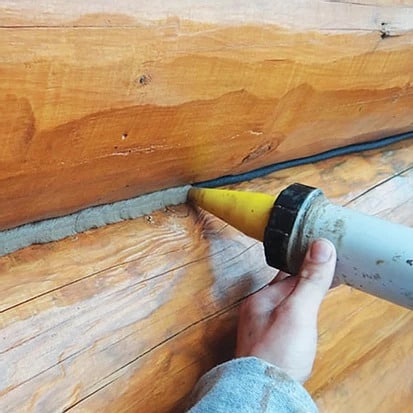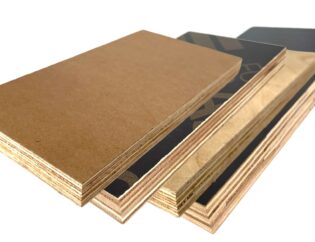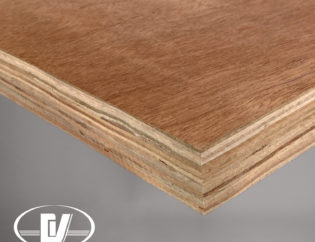
Matt Weber – I don’t own a log home but would love to have my own. A quiet place deep in the woods surrounded by nature, hopefully near a lake … that sounds wonderful. Hey, a guy can dream. I’ve never worked on log home, either, so when we got a question from a Home Improvement and Repair reader about log-home sealants, we turned to our friends at Perma-Chink to break down the options. The following is a guest post from Perma-Chink’s staff of experts. – Matt Weber, editor
How to Choose the Right Sealant for a Log Home
Caulks and specialty log home sealants are used to keep air, water and insects from getting into your home.
Many sealing problems are attributed to the caulking material itself, and most often the proper sealant was not used for the job.
Basically, there are six types of caulks: butyl, oil-based, ethylene vinyl acetate, urethane, silicone and acrylic/latex. All are designed to do a specific job, and none are suitable for every application.
The most frequent mistake made by log home owners is choosing a silicone caulk. Silicone-based caulks are excellent for many applications, but they do not work well on wood. Silicones are formulated for use on non-porous surfaces like metal, plastic or glass. However, wood is porous, and silicones do not adhere to either damp or dry wood. In addition, silicone caulk is difficult to tool and clean up and does not accept a stain or paint.
Presently, the most widely used sealants are acrylic/latex sealants. Although they are suitable for a wide variety of applications, their quality depends on the specific formulation and manufacturer.
Premium acrylic/latex sealants such as Perma-Chink, Energy Seal, Check Mate2 and Woodsman are manufactured from high quality components to perform specific tasks. They are more expensive than a tube of general-purpose caulk, but they are formulated for excellent appearance, high performance and ease of application. These materials are made to be long-lasting in specific uses on your log home.


Don’t Apply New Sealant Over Old Caulking
An application of new sealant over old, failed caulk is rarely a good idea, even if it looks like the caulk is still adhered to the wood. It may take a little more time, but old caulk should be removed for several reasons. If caulk no longer adheres to wood, it may be because moisture got under the caulk creating decay. Old caulk must be removed to properly treat and seal the wood substrate.
Newly applied sealant can only work if it is applied to a clean, sound wood surface or a compatible stain. So, if you want to use the old caulking as a backing material, you can apply new sealant over the surfaces to adhere to clean wood surface beyond where the old caulking reached. Otherwise, you should remove the old stuff.
Removing Old Caulk Betwen Logs
The right tools can make the removal process easy. Remember the old church key used to punch a hole into soda or beer cans? It is a handy tool to scrape out old caulk. Hook knives also work well. If old caulk is a silicone-based caulk, you can usually remove it with your fingers. Always inspect failed caulk areas for evidence of moisture. If the wood is damp, these areas should be properly treated before a new sealant is applied.
When is the Best Time to Seal the Logs?
If you are doing other work, a decision to make early in the process is when to apply your sealants. This decision might have some bearing on which sealant to use. One consideration is that some sealants take a stain much better than others.
Smooth-surfaced caulks like Check Mate 2 do not stain as well as a textured sealant like Energy Seal. If you are planning to apply sealants to your log walls first and then stain afterward, Energy Seal is your best choice.
Usually, the best time to seal logs is after Lifeline stain has been applied. The log surfaces are fresh and clean and whichever Perma-Chink Systems sealant you select will adhere to wood surfaces stained with Lifeline. If you are going to use a topcoat like Lifeline Advance for exteriors or Lifeline Acrylic for interiors, we suggest that the topcoat be applied after the Energy Seal. This gives the most even appearance over the entire wall. However, if you want to really hide the sealant and want a seamless appearance, apply Energy Seal before you stain.
Now let us look at various caulking applications around a log home and select the right product for each job.


Sealing Door and Window Frames
When sealing around window and door frames you have several options.
For either new or older log homes we recommend Energy Seal since it has outstanding elongation and adhesion. This means that as your home settles and shifts, Energy Seal stretches to maintain its bond to the wood. It is available in 12 different colors and since it is textured, it will take the color of the stain.
On chink-style homes many people want the sealant to match their chinking. If that is the case, Perma-Chink can be used to caulk around window and door frames, too.
Checks and Small Gaps in Logs
Upward facing cracks and checks in logs should be filled with Check Mate 2.
Otherwise they collect water that can lead to decay and insect damage. You need not worry about checks on the bottom half of round logs unless they penetrate all the way through the log wall. Choose a color that is closest to the color of the stained logs. If checks are more than ¼ inch wide, stuff a length of backer rod into the check to about 1/4 to 3/8 inch below the surface before filling it with Check Mate 2. The Check-Kit has both backer rod and convenient applicator tubes. For more instructions how to seal checks in logs and log siding click here.
Sealant and Caulk Application
One of the most common mistakes made when sealing logs is to completely fill deep gaps or checks with the sealant material. Quality sealants are made to stretch and elongate with the movement of the joinery. When a sealant is applied too thickly, it loses its ability to stretch and may separate from the wood.
A good rule of thumb is that the thickness of the caulk should be approximately 1/2 the width of the gap you are trying to fill. However, sealant joints never need to be more than 3/8 inches thick. So, how do you fill a large gap?
If you are trying to fill a void behind a window frame for example, Log Gap Cap foam is the product to use. You can also put backer rod into gaps. See step-by-step instructions here.
The space left after installation of the backing material is called the caulking well. This caulking well should be approximately 1/4 to 3/8 inch in depth, regardless of the width. This space is what you will fill with sealant. Some sealant applications have geometries that do not allow for these “textbook”conditions. But, whenever possible, adhere to these specifications for the highest performance seal.
For filling in large voids or gaps, urethane foams are an excellent choice. However, many foam systems have a high expansion ratio which forces foam out of the void you are filling. It is difficult to remove. If you are unsure about your backing material, check with Perma-Chink Systems before using it.
Conclusion
Remember, hot air that gets into your home in the summer and cold air in the winter increases your energy bills.
Water penetration can cause decay and insect nesting. One of the best ways to keep insects out of your log walls is to eliminate the openings where they get in. Properly selected and applied sealants are among your best materials for protecting your home. Use the right sealant for the job for years of protection and comfort.
Vietnam Plywood – Vietnam Film Faced Plywood









